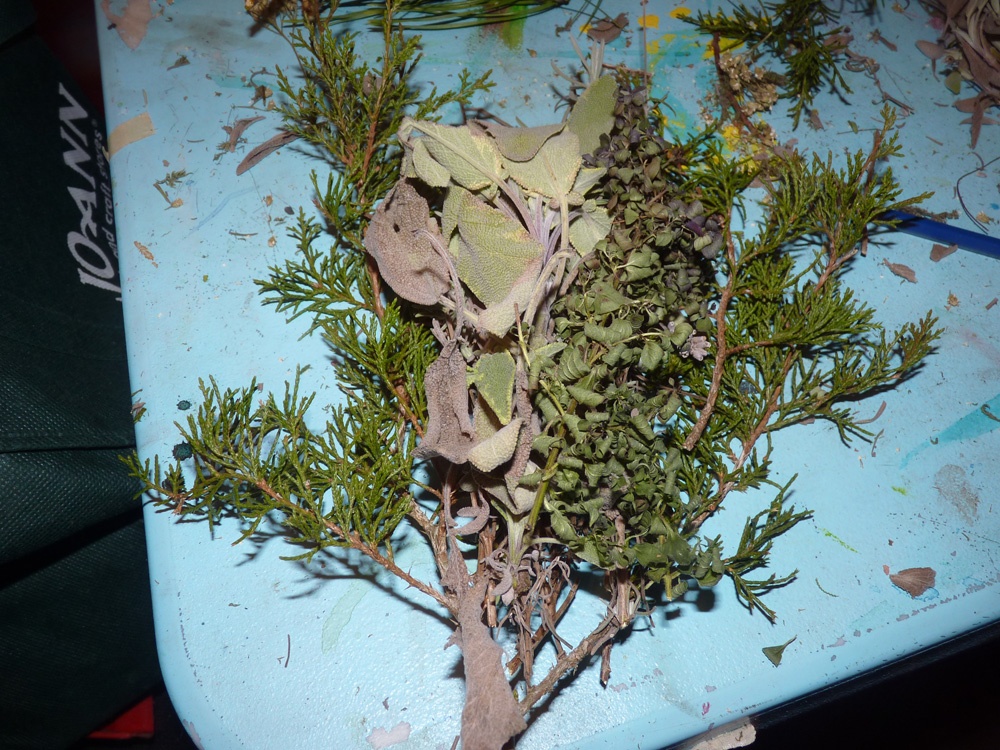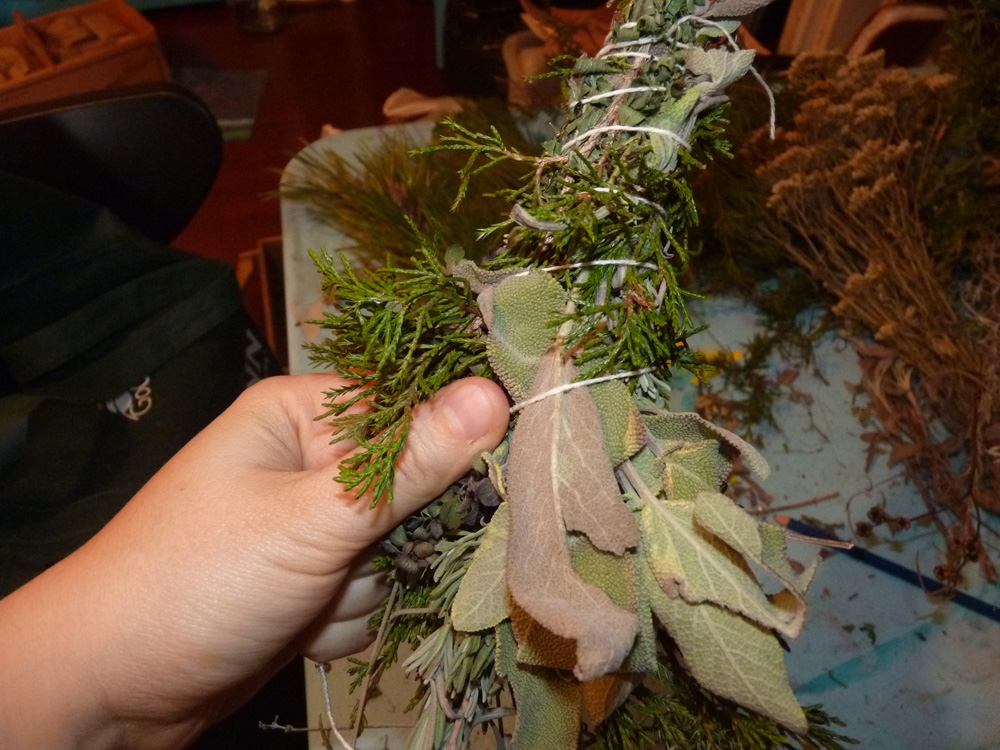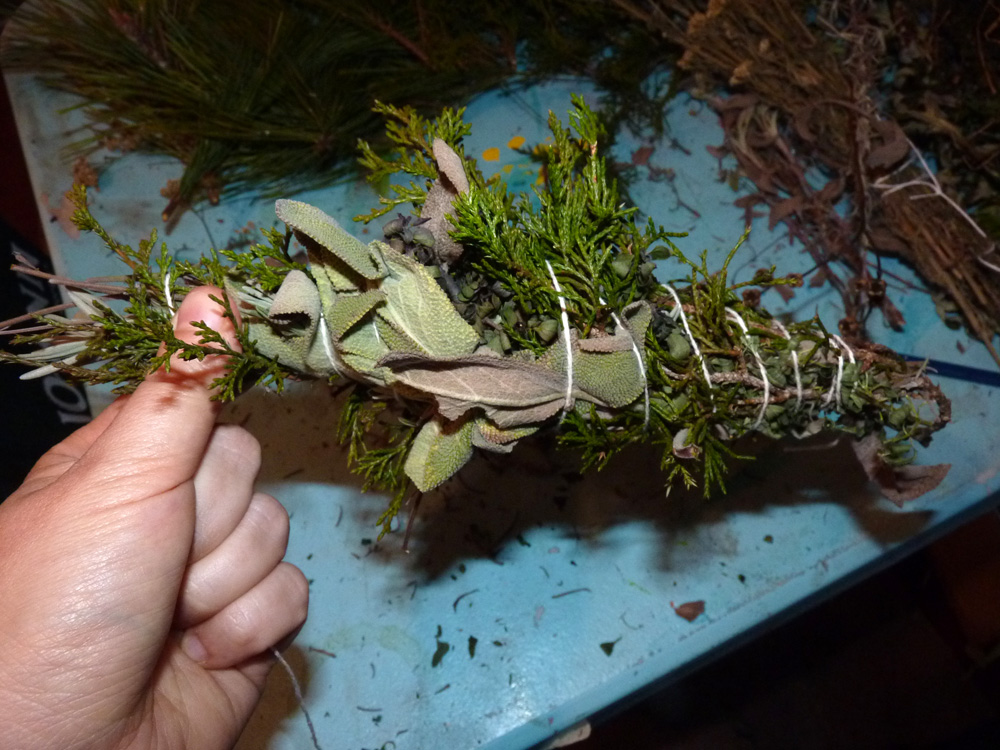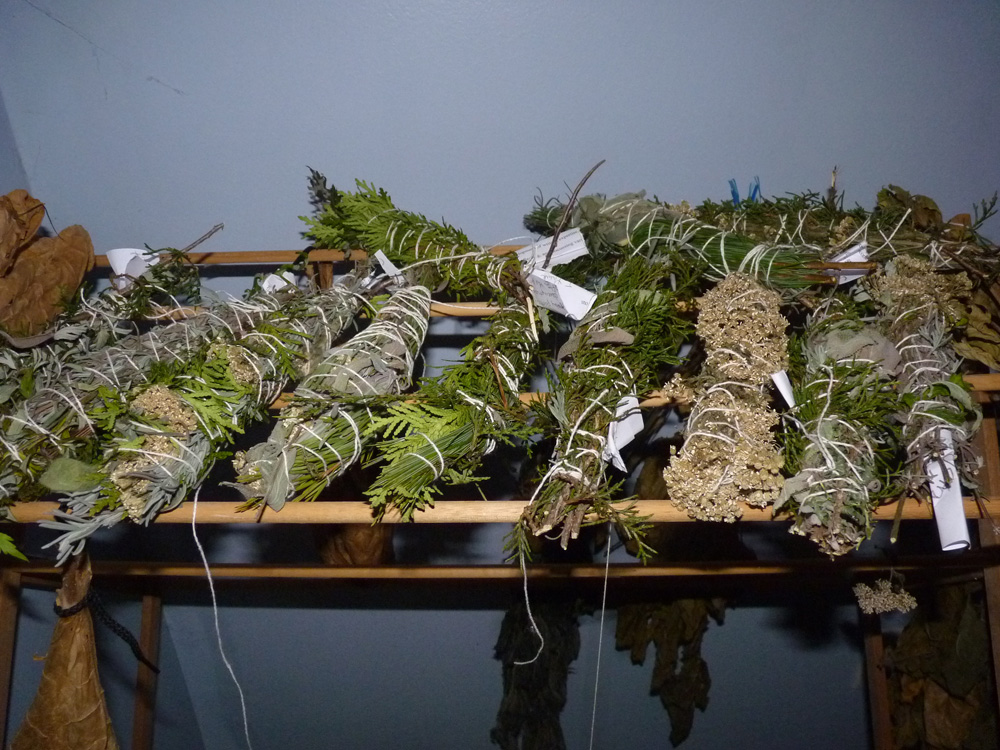How To Make A Cedar Smudge Stick
Smoke clearing sticks (smudge sticks) are bundles of herbs that are stale and burned for purification and ceremonial uses. They are broadly used by many for their purification purposes in a diverseness of unlike cultures, where the terms may be different but the idea is smoke cleansing. The term "smudging" has been recently tied to native American practices, and thus, most people now employ "smoke cleansing" or "saining" instead. I smoke immigration sticks as a druid in my ceremonies, to bless and cleanse my house, to cleanse outdoor spaces that are in some kind of energetic funk. But I also use them practically–as a blessing for my garden at the start of the growing season, as a way to remove hostile energies from my chickens who aren't getting along, or to laissez passer amongst friends earlier sharing a repast. They are a great way to bring a flake of anniversary and the sacred into the everyday.
Why make your own smoke immigration sticks? Sustainability, Institute Marry Relationship Edifice, Intentions

Similar many ritual objects, smudges are often created, shipped, and encased in plastic without a clear sense of their origins or whether or not the plants were harvested in a sustainable way. This means, at minimum, that fossil fuels are expended to get them into your hands and waste material is created in the packaging and processing. As I've discussed on this weblog before, with ritual objects and nutrient and everything else, the objects we choose to apply reflect the energies of their creation. This means that if the sage was grown and harvested conventionally using chemicals that polluted the land, the sage carries those energies. Do yous desire to use that for a sacred ceremony honoring the state? I actually don't retrieve this signal tin exist understated, even though its often disregarded.
There's also the thing of developing close relationships with plants that grow in your bioregion and working with their energies. I have found that if I'thousand called-for traditional smudge plants such as desert sage and incense cedar (plants don't abound nearly me in Michigan), I think some other kind of disconnection occurs–a disconnection with the local plants that might be grown or used for this purpose. Anyone anywhere tin burn desert sage that they purchased at a store–but what makes my region unique is that I can fire mullein or sweet clover in my smudges along with a more traditional sage. I desire to honor the plants that grow here; I want to grow plants ceremonially for this purpose, and be involved in every aspect of the creation of an object used for sacred activity. So given the reasons above, I've taken to making my own smudge sticks!
If you are crafting your ain smudge sticks, you lot can develop them for specific purposes. A mullein-sage-rosemary smudge for personal clearing would exist dissimilar than a sage-sweetness clover-cedar smudge for typical house cleansing or a juniper-lavender-mugwort smudge for good dreaming. You can craft smudges that can exist used for dissimilar purposes and craft them with intent.
Determining Energetic Qualities of Plants

I utilise a combination of readings on magical herbalism from the western tradition, traditional western herbalism, the doctrine of signatures, my ain understandings/intuition, and my piece of work with institute allies to make up one's mind what plants should become in what smudges. Sometimes I craft smudges by intuition lonely, and and so accept them ready to requite a friend or use when I feel led. Other times, I research the plants or put plants together that I know serve a specific purpose (like mugwort for travels or dreams). The process here should exist of your own design, and for that reason, I'k not giving y'all general "use this plant for this" because A) there'south a lot of that out at that place already; B) the plants don't like to be put into such boxes; and C) many plants have multiple, varied uses. Sage works for so much more than just purification, for example, but if yous look it upwards, you'll notice it listed time and time once more for purification and cleansing. Yeah, sage is bang-up at that, merely sage has other uses! And furthermore, if you lot are using wildcrafted and local ingredients, there might *non* be a magical tradition surrounding that plant–just you lot even so may feel led to use it. That's perfectly fine–you tin let the institute spirit and your intuition guide your path.
Finding Local Plants for Your Smudges
In the side by side department, I'll exist talking about some of the plants that I use to brand smudges. These plants are local to my bioregion (zone 6A, Due south-eastern Michigan) so you lot may accept to adjust this listing. If you aren't certain if the constitute in your bioregion would make a nice smudge, merely dry some out and burn it; with ane caveat–I never burn noxious or poisonous plants, merely plants I know are used for herbalism or nutrient (due east.g. do Not EVER burn poisonous substance ivy or poison hemlock). Use some common sense. Only if the establish already has uses every bit a medicinal herb, edible herb, or smoking herb, then its perfectly fine to see if yous tin use it for a smudge. See how it smells, run across how energetically it makes you experience. See if it smolders (smoldering plants, like mullein or sage, are particularly useful for smudges). Pay attention to the conifer trees that abound nearby–chances are many of them burn nicely and odour practiced.
Plants that Can Get Into Smudges

1) Aromatic Cultivated herbs. Aromatic herbs are one of my biggest categories of plants for crafting smudges–aromatic herbs are herbs that odor strongly when you lot rub them. Many aromatic herbs make corking additions to smudge sticks because they scent great and have good energetic qualities of clearing. Exist conscientious, however–non all effluvious herbs burn the way they olfactory property–make sure you burn a fleck before adding them into your smudges or you may be in for a surprise. Mint and lemon balm are a good example of this–mint and lemon balm smell and gustation amazing, unfortunately, neither burn with a pleasant scent. Other aromatic herbs, like valerian, are extremely potent when burned (and are extremely stiff in general) so you'll want to use caution. These are the aromatic herbs that I've constitute through incense making and trial and fault work well:
- Sage – White sage has the most singled-out smell, but many sages smell wonderful. Even garden sage burns with a pleasant odor, pleasant merely different than white sage. I abound many different kinds of sages for my smudges.
- Rosemary – Rosemary is another staple for smudges. Interestingly enough, you can utilize both the root and the plant of rosemary–and they take unlike qualities. The rosemary stalks burn wonderfully in a smudge.
- Lavender – I similar to include a quite flake of lavander in my smudges for both the pleasant aroma and the energetic qualities–information technology smells simply wonderful when burned and is a powerful institute marry.
- Sweetness Grass – This does not abound around me, and thus far, my attempts to go any started from seed have been thwarted. However, if you can grow or obtain some ethically, information technology is a wonderful addition for a lot of reasons (good smelling, honors the spirits).
- Hyssop – An herb with ancient connections to purification piece of work. Hyssop smells wonderful.
- Eucalyptus – Another herb for clearing work; its smolders nicely. You take to plant this in my region–it doesn't grow wild, but will grow to a nice size over the summer.
- Valerian – I have used dried valerian flower stalks in my smudges primarily, although I suppose the roots would work as well (the roots would exist even more potent). Valerian is extremely potent as both a cleansing herb but also in smell–I would just use a little in a smudge, and that smudge would be typically reserved for clearing really nasty energies or hostile energies out (and I'd burn information technology with the windows open).
- Bay leafage: I have as well had luck with bay leaf as a smoldering herb.

2) Wildharvested Aromatic and Medicinal Herbs: In addition to those you can grow in your garden, I take plant that a number of wild harvested herbs are wonderful for smudges. I got most of the ideas for these when I was taking my four flavor herbalism course and we were talking most smoking blends. If they work in a smoking blend and are safe for that, they tin piece of work cracking in a smudge likewise!
- Mugwort – Mugwort has a prissy odour when burned (and its used in a lot of herbal smoking blends). Mugwort is specifically tied to dreams and can produce very brilliant dreaming. While this is a good affair brusk term, do go on in mind that vivid dreams over a long period of fourth dimension can exhaust yous–so use mugwort with intendance, but definitely use information technology! Mugwort also grows beautifully straight and tall, and really does practise well in smudges. A lot of people cultivate mugwort, but I find it wild growing everywhere around hither. I really dearest this plant.
- Sweet Clover – This is my solution to the lack of sweet grass–sugariness clover does not burn as sweetly, but energetically, it has similar qualities and a similar scent. And it grows wild around here (and my bees admire it).
- Mullein – Mullein leaves take a nice "smoldering" quality–they smolder in the same way that sage smolders. They don't smell well-nigh equally nice, but the fume itself does have a benign impact on the lungs and tin, medicinally, be used for "clearing" out the lungs of toxins. Follow me hither–in Buddhist practise, the lungs are said to house grief. I call up, for a personal smudge stick where I was working to clear out some deep emotions and emotional recovery, I would almost definitely put mullein in it
- Yarrow: Yarrow is another herb I like to employ a lot in my smudges for its energetic qualities; information technology smells a lot like itself when it burns due to the high volatile oil content.
2) Trees. Traditionally, cedars (like incense cedar or cherry cedar) were used for smudges out w. In my bioregion, I look primarily to the conifer for smudging possibilities (you can cutting these and utilize them fresh):
- Eastern Red Cedar/Juniper (Juniperus virginiana) : This is a wonderfully aromatic plant with berries that also are used medicinally. I dearest using juniper in my smudges–simply it has little prickly bits, so use it carefully and so that yous don't go stabbed.
- Eastern White Cedar (Thuja Occidantalis): Eastern White Cedar crackles and pops when it is freshly dry due to its high amount of volatile oils. If y'all use the cedar branches when they are first dried, they smell wonderful but literally crepitation and pop when you fire them due to all of the volatile oils—which is a bit of a fire gamble, only also can kind of be fun. However, if yous hang the cedar in your house for a few months and permit it dry out out, the oils slowly dry out of the cedar and so you can make your smudge sticks. The sticks at this betoken will smoke beautifully.
- White Pino (Pinus Strobus): I'm still experimenting with this as a smudge tree, simply so far, I'k happy with the results and it burns with an almost vanilla-like smell. Wonderful!
- Staghorn sumac: You tin can make smudges with small clusters of berries and or collect and use the leaves later they have gone red in the fall. Staghorn sumac has a very calming consequence (I use information technology equally an herbal smoke for my bees) and smolders nicely–plus, information technology is a beautiful ruby-red colour that provides visual beauty in your smudge. It has a fairly pleasant fume (not very aromatic).
three) Flowers. There is also a visual component to making a nice smudge stick, and I recollect this is where various wild flowers can lend a hand. Most of the flowers don't accept a peculiarly strong odour when burned, but a bit of purple or yellowish or white in your smudge tin can look absolutely beautiful (and add energetically to your smudge). A visit to whatever flower field in the height of the summer will certainly give you lot much to work with. You can besides cultivate flowers like statice or infant's breath which concur their beautify for long periods of time for your smudges (I would not purchase these commercially equally they are almost e'er sprayed with something you lot don't want to make airborne). I similar using goldenrod, yarrow, and lavender in the after part of the season for this.
Stride-past-Stride Instructions for Making your Smudge
Now that we have some sense of what ingredients can be used in a smudge, the next step is gathering them and actually making the smudge!
Footstep 1: Gather Materials. Get out and assemble your materials–bring in your fresh conifer branches, your dried yarrow stalks, etc. I have establish that plants can be gathered and used fresh or dried, but the fresh ones take longer to dry out (and you want to brand sure its not humid so that the inner ones don't mold). I typically brand smudges in late fall after the frost has wilted the plants a scrap and semi-dried them out (its a way to use up the last herbs of the flavor).
In addition to the herbs/plants, you lot'll also need some cotton string (don't use annihilation synthetic since you will be burning it) and some pair of scissors. If there is a kitten in the habitation you might want to keep her out of the room, as otherwise she will attack the herbs and strings as you endeavour to make your smudges :).
Footstep 2: Ready intentions. I like to create a sacred space for magical crafting prior to starting any such endeavor. Different traditions would practise this in unlike ways, of course, and you might merely do something simple to setup your infinite. For my tradition, I open a grove and then work in that grove.
Step 3: Start with some conifers. I like to wrap conifers around the exterior of the smudge (this is personal preference) and so I'll lay out a bed of conifers first. In the photograph below, I've started this smudge with juniper (freshly cut that morning) and lavender (also cut that forenoon from outside in early on Dec).

Step four: Add together additional ingredients, layering them. To this smudge I've added some semi-dried out thyme from exterior and some semi-dried out garden sage.

Step 5: Gather your ingredients up in one paw and loosely bunch them. Cut a long piece of the string and begin wrapping your ingredients.

Pace vi: Continue to wrap the ingredients. If you wrap them besides tight, the smudge may not burn down (depending on what'south in it) so experiment with your herbs/plants and tightness. I similar to take my cotton string upward and down the smudge twice, which helps agree it together a bit ameliorate than merely one trip up and down. The photos below show dissimilar parts of the wrapping process.


Step seven: Tie your smudge off so that its secure.

Stride viii: Once y'all've wrapped your smudge, you tin trim it up a bit. I trim both the ends and the little $.25 that stick out (they will take trouble burning).


Pace 9: Permit your smudge to dry out 4-8 weeks (depending on what'southward within and how moisture it was when you put information technology in there). I like to utilize a wooden drying rack (I utilise this for a lot of of my herb drying); the rack was $iii at a g auction!

I hope that you institute the above information useful–if there are other plants I should add to my lists above, or plants that work well in your bioregion, please leave a annotate! Cheers, as always, for reading!
Source: https://thedruidsgarden.com/2014/12/14/making-smudge-sticks-from-homegrown-plants-and-wildharvested-materials-step-by-step-instructions-with-cedar-rosemary-sage-mugwort-and-more/

0 Response to "How To Make A Cedar Smudge Stick"
Post a Comment